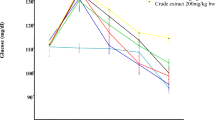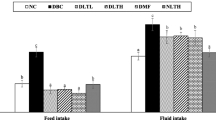Abstract
Semecarpus anacardium Linn. nut milk extract (SA) was evaluated for its antidiabetic role in type 2 diabetic rats. Type 2 diabetes was induced in rats by feeding high-fat diet for 2 weeks followed by single intraperitoneal injection of streptozotocin 35 mg/kg body weight. Diabetic rats were treated with SA orally at a dosage of 200 mg/kg body weight daily for 30 days. Metformin (500 mg/kg body weight, orally) was used as a reference drug. SA significantly (p < 0.05) reduced the blood glucose levels and decreased the levels of HbA1c and the glucose intolerance. SA treatment significantly (p < 0.05) decreased the increase in lipid profile. The levels of urea, uric acid and creatinine were restored to near normal levels when compared with control diabetic rats. The histopathological abnormalities were also found to be normalized after treatment with SA nut milk extract. The potential antihyperglycemic action of SA is plausibly due to its underlying antioxidant role.







Similar content being viewed by others
References
Al-Shamaony L, Al-Khazraji SM, Twaiji HA (1994) Hypoglycemic effect of Artemisia herba alba. II: effect of a valuable extract on some blood parameters in diabetic animals. J Ethnopharmacol 43:167–171
Aragno M, Mastrocola R, Catalano MG, Brignardello E, Danni O, Boccuzzi G (2004) Oxidative stress impairs skeletal muscle repair in diabetic rats. Diabetes 53:1082–1088
Aravind SG, Arimboor R, Rangan M, Madhavan SN, Arumughan C (2008) Semi-preparative HPLC preparation and HPTLC quantification of tetrahydroamentoflavone as marker in Semecarpus anacardium and its polyherbal formulations. J Pharm Biomed Anal 48:808–813
Arul B, Kothai R, Christina AJ (2004) Hypoglycemic and antihyperglycemic effect of Semecarpus anacardium Linn. in normal and streptozotocin-induced diabetic rats. Methods Find Exp Clin Pharmacol 26:759–762
Caraway WT (1963) Quantitative determination of uric acid. Clin Chem 4:239–243
Choi MS, Jung UJ, Yeo J, Kim MJ, Lee MK (2008) Genistein and daidzein prevent diabetes onset by elevating insulin level and altering hepatic gluconeogenic and lipogenic enzyme activities in non-obese diabetic (NOD) mice. Diabetes Metab Res Rev 24:74–81
Drabkin AL, Austin JM (1932) Spectrophotometric studies spectrometric constants for common haemoglobin derivatives in human, dog and rabbits blood. J Biol Chem 98:719–739
Du Vigneaud V, Karr WG (1925) Carbohydrate utilization Rate of disappearance of d-glucose from the blood. J Biol Chem 66:281–300
Formulary of Siddha Medicine (1972) 2nd edn. Indian Medicine Practitioners Co-operative Pharmacy and Stores Ltd, Madras, p. 197
Khan HBH, Vinayagam KS, Palanivelu S, Panchanatham S (2011) J Comp Clin Pathol
Lu HE, Jian CH, Chen SF, Chen TM, Lee ST, Chang CS, Weng CF (2010) Hypoglycaemic effects of fermented mycelium of Paecilomyces farinosus (G30801) on high-fat fed rats with streptozotocin-induced diabetes. Indian J Med Res 131:696–701
Mathews DR, Hosker JP, Rudenkl AS, Naylor BA, Treacher DF, Turner RC (1985) Homeostasis model assessment: insulin resistance and β-cells function from fasting plasma glucose and insulin concentrations in man. Diabetologia 28:412–419
Nair PKR, Melnick SJ, Wnuk SF, Rapp M, Escalon E, Ramachandran C (2009) Isolation and characterization of an anticancer catechol compound from Semecarpus anacardium. J Ethnopharmacol 3:450–456
Natelson S, Scott ML, Beffa C (1951) A rapid method for the estimation of urea in biologic fluids. Am J Clin Pathol 21:275–281
Osei K, Rhinesmith S, Gaillard T, Schuster D (2004) Impaired insulin sensitivity, insulin secretion, and glucose effectiveness predict future development of impaired glucose tolerance and type 2 diabetes in pre-diabetic African Americans: implications for primary diabetes prevention. Diabetes Care 27:1439–1446
Owen JA, Iggo B, Scandrett FJ, Stewart CP (1954) The determination of creatinine in plasma or serum, and in urine: a critical examination. Biochem J 58:426–437
Palsamy P, Subramanian S (2008) Resveratrol, a natural phytoalexin, normalizes hyperglycemia in streptozotocin-nicotinamide induced experimental diabetic rats. Biomed Pharmacother 62:598–605
Parveen K, Khan MR, Mujeeb M, Siddiqui WA (2010) Protective effects of Pycnogenol on hyperglycemia-induced oxidative damage in the liver of type 2 diabetic rats. Chemico Biol Interact 186: 219–227
Rai PK, Singh SK, Kesari AN, Geeta Watal (2007) Glycemic evaluation of Psidium guajava in rats. Indian J Med Res 126:224–227
Ramadan MF, Kinni SG, Seshagiri M, Morsel J-T (2010) Fat-soluble bioactives, fatty acid profile and radical scavenging activity of Semecarpus anacardium seed oil. J Am Oil Chem Soc 87:885–894
Ramprasath VR, Shanthi P, Sachdanandam P (2005) Evaluation of antioxidant effect of Semecarpus anacardium Linn. nut extract on the components of immune system in adjuvant arthritis. Vascul Pharmacol 4:179–186
Rao P, Pattabiraman TN (1990) Further studies on the mechanism of phenol–sulfuric acid reaction with furaldehyde derivatives. Anal Biochem 189:178–181
Sharma AK, Bharti S, Goyal S, Arora S, Nepal S, Kishore K, Joshi S, Kumari S, Arya DS (2011) Upregulation of PPARc by Aegle amarmelos ameliorates insulin resistance and β-cell dysfunction in high fat diet fed streptozotocin induced type 2 diabetic rats. Phytother Res 10:1457–1465
Shin YG, Cordell GA, Dong Y, Pezzuto JM, Appa Rao AVN, Ramesh M, Ravi Kumar B, Radhakishan M (1999) Rapid identification of cytotoxic alkenyl catechols in Semecarpus anacardium using bioassay-linked high performance liquid chromatography–electrospray/mass spectrometric analysis. Phytochem Anal 4:208–212
Singleton JR, Smith AG, Russell JW, Feldman EL (2003) Microvascular complications of impaired glucose tolerance. Diabetes 5(2):2867–2873
Srinivasan K, Viswanad B, Lydia Asrat, Kaul CL, Ramarao P (2005) Combination of high-fat diet-fed and low-dose streptozotocin-treated rat: a model for type 2 diabetes and pharmacological screening. Pharmacol Res 52:313–320
Trinder P (1969) Determination of blood glucose using an oxidase–peroxidase system with a noncarcinogenic chromogen. J Clin Pathol 22:158–161
Umarani M, Shanthi P, Sachdanandam P (2008) Protective effect of Kalpaamruthaa in combating the oxidative stress posed by aflatoxin B1-induced hepatocellular carcinoma with special reference to flavonoid structure-activity relationship. Liver Int 28:200–213
Wild S, Roglic G, Green A, Sicree R, King H (2004) Global prevalence of diabetes: estimates for the year 2000 and projections for 2030. Diabetes Care 27:1047–1053
Wilson DE, Spiger MJ (1973) A dual precipitation method for quantitative plasma lipoprotein measurement without ultracentrifugation. J Lab Clin Med 82:473–482
Xie WD, Du LJ (2005) High-cholesterol diets impair short-term retention of memory in alloxan-induced diabetic mice, but not acquisition of memory in prediabetic mice. Life Sci 77:481–495
Ethical standards
Animal experimentation was conducted according to the current institutional regulations (IBMS) IAEC no.: 02/081/07.
Author information
Authors and Affiliations
Corresponding author
Rights and permissions
About this article
Cite this article
Khan, H.B.H., Vinayagam, K.S., Renny, C.M. et al. Potential antidiabetic effect of the Semecarpus anacardium in a type 2 diabetic rat model. Inflammopharmacol 21, 47–53 (2013). https://doi.org/10.1007/s10787-012-0136-6
Received:
Accepted:
Published:
Issue Date:
DOI: https://doi.org/10.1007/s10787-012-0136-6




